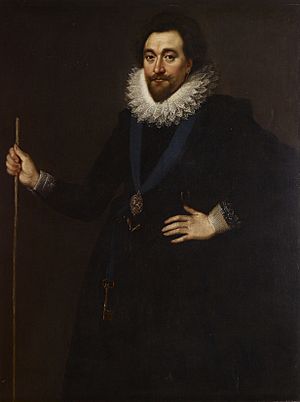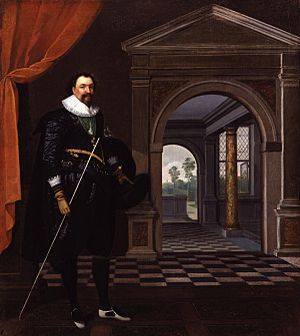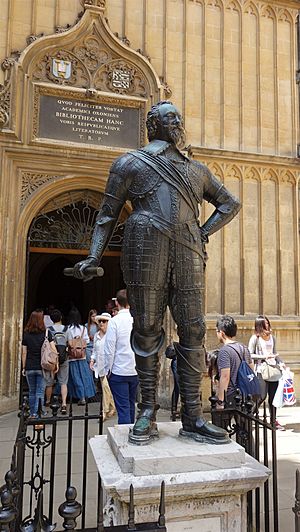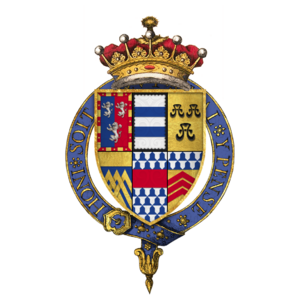William Herbert, 3rd Earl of Pembroke facts for kids
Quick facts for kids
The Earl of Pembroke
|
|
|---|---|

Portrait by Paul van Somer I, 1617
|
|
| Born | 8 April 1580 |
| Died | 10 April 1630 (aged 50) |
| Spouse(s) | Lady Mary Talbot |
| Children | 2 sons |
| Parent(s) | Henry Herbert, 2nd Earl of Pembroke Mary Sidney |


William Herbert, 3rd Earl of Pembroke (born April 8, 1580 – died April 10, 1630) was an important English nobleman, politician, and courtier. He lived at Wilton House in Wiltshire, England.
He held many significant positions during his lifetime. He was the Chancellor of the University of Oxford and helped King James I start Pembroke College, Oxford. He also served as the Lord Chamberlain, a high-ranking official in the royal household, from 1615 to 1625. A very famous fact about him is that the first collection of Shakespeare's plays, known as the First Folio, was dedicated to him and his brother in 1623.
Contents
Early Life and Family
William Herbert was the oldest son of Henry Herbert, 2nd Earl of Pembroke. His mother was Mary Sidney, who was also a well-known writer. He grew up at Wilton House, a large and important family estate.
A Life at Court and in Politics
William Herbert was a very intelligent person who enjoyed reading. He was even taught by the poet Samuel Daniel when he was younger. Despite his love for books, he was a noticeable figure at the court of King James I. He and his brother Philip even performed in a play called The Masque of Indian and China Knights at Hampton Court in 1604.
He often disagreed with the plans of the powerful Duke of Buckingham. William Herbert was also very interested in the idea of colonizing the Americas.
He held several important government jobs:
- He was the Lord Chamberlain of the Royal Household from 1615 to 1625.
- He was the Lord Steward from 1626 to 1630.
- He was appointed Warden of the Forest of Dean and Constable of St Briavels Castle in 1608.
- In 1609, he became the Governor of Portsmouth. He kept all these jobs until he died.
In 1624, he became the Chancellor of the University of Oxford. Pembroke College, Oxford was named in his honor because of his support for the university.
Marriage and Children
On November 4, 1604, William Herbert married Mary Talbot. She was the daughter of Gilbert Talbot, 7th Earl of Shrewsbury. They had two sons, James (born in 1616) and Henry (born in 1621), but sadly, neither of them lived past infancy.
Death and Who Came Next
William Herbert, the 3rd Earl of Pembroke, passed away in 1630, just two days after his 50th birthday. Since he had no sons who survived, his titles were passed on to his younger brother, Philip. William Herbert was buried in his family's burial place in Salisbury Cathedral in Wiltshire.
William Herbert and Shakespeare
Some people believe that William Herbert is the "Fair Youth" mentioned in William Shakespeare's sonnets. In these poems, the poet encourages a young man to get married. William Herbert was younger than Shakespeare and was a supporter of his plays. The dedication of Shakespeare's Sonnets is to a "Mr. W.H.", and some think this refers to William Herbert.
The idea that Herbert was the "Fair Youth" was first suggested in 1837. Later, a scholar named E. K. Chambers changed his mind and thought Herbert was more likely the person, especially after seeing letters that showed Herbert was encouraged to marry Elizabeth Carey.
Even though there's no proof that Herbert ever met Shakespeare from Stratford-upon-Avon, the First Folio of Shakespeare's plays, which was published after Shakespeare died, was dedicated to "the incomparable pair of brethren," meaning William Herbert and his brother Philip.
William Herbert was also a very important supporter of the arts and was part of a group of artists and thinkers known as the Whitehall group.
His Statue at Oxford
A life-sized bronze statue of William Herbert, 3rd Earl of Pembroke, was created by the sculptor Hubert Le Sueur. This statue was originally at his family home, Wilton House. In 1723, Thomas Herbert, 8th Earl of Pembroke, gave the statue to the Bodleian Library at Oxford University.
This gift was made to honor William Herbert's role as Chancellor of the University of Oxford from 1617 until his death. He also helped to establish Pembroke College and gave many old books and papers to the Bodleian Library in 1629.
The statue was first placed inside the Bodleian Picture Gallery. But in 1950, it was moved outside to its current spot in front of the main entrance of the Old Bodleian Library. It is considered a Grade II listed monument.
The stone base of the statue has Latin words carved into it. One side says that William, Earl of Pembroke, was a royal official and a very generous Chancellor of Oxford University. The other side explains that Thomas, Earl of Pembroke and Montgomery, gave this statue of his great-uncle to the university in 1723.
See also
- Codex Baroccianus


